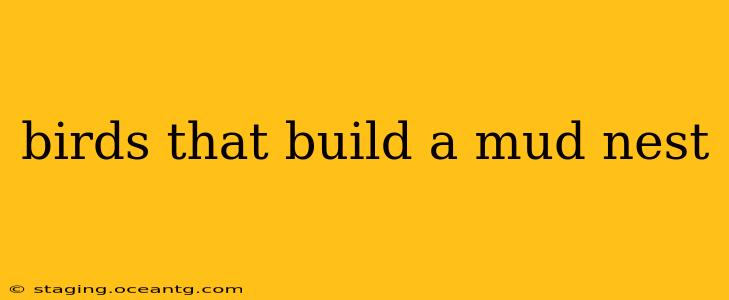Many bird species utilize mud as a key component in constructing their nests, showcasing remarkable ingenuity and adaptability. Mud provides strength, stability, and protection from the elements, making it a valuable building material in diverse environments. This article explores various bird species known for their mud nests, highlighting their unique nesting behaviors and adaptations.
What Birds Build Mud Nests?
Several bird families incorporate mud into their nest construction, each with its own techniques and nest designs. Some of the most well-known examples include swallows, ovenbirds, and certain species of wrens. The specific type of mud used, the nest's architecture, and the location chosen all vary depending on the species.
What Kind of Mud Do Birds Use for Their Nests?
Birds don't just grab any mud; they are quite discerning! They typically select moist, pliable mud, often from riverbanks, ponds, or puddles. The ideal consistency allows them to shape and mold the mud into the desired form. The addition of other materials like twigs, grass, saliva (as a binding agent), and even feathers further strengthens and refines the structure.
How Do Birds Build Mud Nests?
Nest building is a meticulous process, often involving both parents. The process typically includes:
- Gathering materials: Collecting mud, twigs, and other components.
- Building the structure: Shaping the mud into the foundation and walls of the nest, often layering it to create strength and insulation.
- Adding interior lining: Softening the nest's interior with softer materials like grass, leaves, or feathers.
The specific methods vary greatly depending on the species. Some birds build simple mud cups, while others create elaborate structures with intricate designs.
What are Some Examples of Birds That Use Mud in Their Nests?
Here are a few examples showcasing the diversity of mud nest builders:
- Swallows (Hirundinidae): Many swallow species build open-cup nests of mud pellets attached to cliffs, bridges, or buildings. They are known for their skillful manipulation of mud to create a sturdy and stable structure.
- Ovenbirds (Furnariidae): True to their name, many ovenbirds construct dome-shaped mud nests resembling ovens. These nests are incredibly strong and provide excellent protection from predators and the elements.
- Rufous-collared Sparrow (Zonotrichia capensis): This species is known for incorporating mud into the construction of its nest, which is typically built in shrubs or trees. The mud helps to provide structural stability and protection.
- Certain Wren Species: Some wren species, especially those found in tropical regions, incorporate mud into their nest construction, creating diverse shapes and sizes depending on the available resources and species-specific behaviors.
Where Do Birds Build Mud Nests?
Nest location is crucial for survival and varies significantly among species. Some common nesting sites include:
- Cliff faces: Offering protection from ground-based predators.
- Under bridges or eaves of buildings: Providing shelter from the elements and some protection from predators.
- Trees and shrubs: Camouflaging the nest and offering some protection.
- Cavities in rocks or trees: Providing additional security.
The location selection depends heavily on the species, availability of resources, and the level of protection offered.
Why Do Birds Build Mud Nests?
Mud offers several advantages for nest construction:
- Strength and stability: Providing a strong foundation and resisting harsh weather conditions.
- Protection from predators: The robust structure offers defense against many predators.
- Insulation: Keeping the eggs and chicks warm in cold climates.
- Camouflage: Blending the nest with the surroundings.
What are the Challenges Birds Face When Building Mud Nests?
Building a mud nest isn't without its challenges:
- Weather dependence: Mud's workability is heavily reliant on appropriate moisture levels. Too dry, and it crumbles; too wet, and it’s too difficult to manipulate.
- Predator vulnerability: While offering protection, the construction process can leave the birds vulnerable to predators.
- Resource availability: Suitable mud isn't always readily available.
This comprehensive guide sheds light on the fascinating world of birds that build mud nests, highlighting their impressive engineering skills and adaptive strategies for survival. The variety in nest designs, materials used, and nesting locations underscores the remarkable diversity within the avian world.
